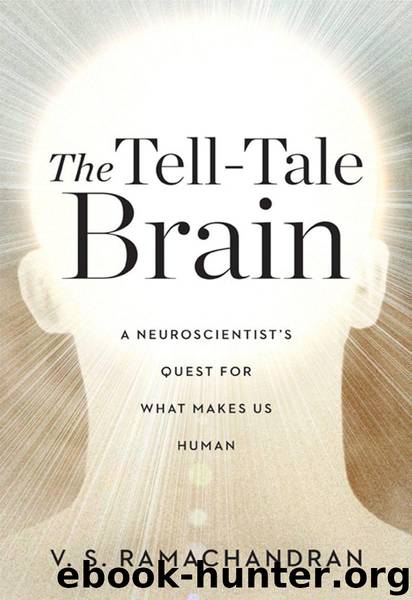The Tell-Tale Brain: A Neuroscientist's Quest for What Makes Us Human by Ramachandran V. S

Author:Ramachandran, V. S. [Ramachandran, V. S.]
Language: eng
Format: mobi
Publisher: W. W. Norton & Company
Published: 2011-01-16T16:00:00+00:00
RECALL THE SIMPLE bouba-kiki experiment. Could it hold the key to understanding how the first words evolved among a band of ancestral hominins in the African savanna between one and two hundred thousand years ago? Since words for the same object are often utterly different in different languages, one is tempted to think that the words chosen for particular objects are entirely arbitrary. This in fact is the standard view among linguists. Now, maybe one night the first band of ancestral hominins just sat around the tribal fire and said,
“Okay, let’s all call this thing a bird. Now let’s all say it together, biiirrrrddddd. Okay let’s repeat again, birrrrrrrdddddd.”
This story is downright silly, of course. But if it’s not how an initial lexicon was constructed, how did it happen? The answer comes from our bouba-kiki experiment, which clearly shows that there is a built-in, nonarbitrary correspondence between the visual shape of an object and the sound (or at least, the kind of sound) that might be its “partner.” This preexisting bias may be hardwired. This bias may have been very small, but it may have been sufficient to get the process started. This idea sounds very much like the now discredited “onomatopoeic theory” of language origins, but it isn’t. “Onomatopoeia” refers to words that are based on an imitation of a sound—for example, “thump” and “cluck” to refer to certain sounds, or how a child might call a cat a “meow-meow.” The onomatopoeic theory posited that sounds associated with an object become shorthand to refer to the objects themselves. But the theory I favor, the synesthetic theory, is different. The rounded visual shape of the bouba doesn’t make a rounded sound, or indeed any sound at all. Instead, its visual profile resembles the profile of the undulating sound at an abstract level. The onomatopoeic theory held that the link between word and sound was arbitrary and merely occurred through repeated association. The synesthetic theory says the link is nonarbitrary and grounded in a true resemblance of the two in a more abstract mental space.
What’s the evidence for this? The anthropologist Brent Berlin has pointed out that the Huambisa tribe of northern Peru have over thirty different names for thirty bird species in their jungle and an equal number of fish names for different Amazonian fishes. If you were to jumble up these sixty names and give them to someone from a completely different sociolinguistic background—say, a Chinese peasant—and ask him to classify the names into two groups, one for birds, one for fish, you would find that, astonishingly, he succeeds in this task well above chance level even though his language doesn’t bear the slightest shred of resemblance to the South American one. I would argue that this is a manifestation of the bouba-kiki effect, in other words, of sound-shape translation.1
But this is only a small part of the story. In Chapter 4, I introduced some ideas about the contribution mirror neurons may have made to the evolution of language. Now, in the remainder of this chapter, we can look at the matter more deeply.
Download
This site does not store any files on its server. We only index and link to content provided by other sites. Please contact the content providers to delete copyright contents if any and email us, we'll remove relevant links or contents immediately.
| Anatomy | Animals |
| Bacteriology | Biochemistry |
| Bioelectricity | Bioinformatics |
| Biology | Biophysics |
| Biotechnology | Botany |
| Ecology | Genetics |
| Paleontology | Plants |
| Taxonomic Classification | Zoology |
Sapiens: A Brief History of Humankind by Yuval Noah Harari(14209)
The Tidewater Tales by John Barth(12594)
Mastermind: How to Think Like Sherlock Holmes by Maria Konnikova(7195)
Do No Harm Stories of Life, Death and Brain Surgery by Henry Marsh(6875)
The Thirst by Nesbo Jo(6806)
Why We Sleep: Unlocking the Power of Sleep and Dreams by Matthew Walker(6594)
Life 3.0: Being Human in the Age of Artificial Intelligence by Tegmark Max(5446)
Sapiens by Yuval Noah Harari(5280)
The Longevity Diet by Valter Longo(5006)
The Body: A Guide for Occupants by Bill Bryson(4949)
The Rules Do Not Apply by Ariel Levy(4821)
The Immortal Life of Henrietta Lacks by Rebecca Skloot(4500)
Animal Frequency by Melissa Alvarez(4382)
Why We Sleep by Matthew Walker(4340)
The Hacking of the American Mind by Robert H. Lustig(4301)
Yoga Anatomy by Kaminoff Leslie(4288)
All Creatures Great and Small by James Herriot(4211)
Double Down (Diary of a Wimpy Kid Book 11) by Jeff Kinney(4175)
Barron's AP Biology by Goldberg M.S. Deborah T(4080)
